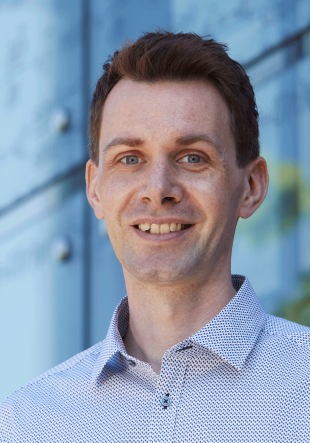Topological phase controlled nonlinear optical processes at metasurfaces
Overview
Nanostructured surfaces for optical applications gained recently much interest due to their high potential for applications and the simple fabrication methods that are compatible with standard CMOS technology. In our previous work we demonstrated that nanostructured surfaces, so-called metasurfaces, can provide a topological (Berry) phase for circularly polarized light that solely depends on the orientation of the unit-cells. Since this topological phase can be freely engineered in the design process arbitrary functionalities like lenses, beam shapers, or even holograms can be obtained by a single interface. With our proposal we will go beyond this recent progress and extent the concept of the topological phase for the first time to nonlinear optics and nonlinear metasurfaces. Our proposed concept would allow tailoring the spatial phase of the nonlinear material polarization in a nonlinear optical process at will. Here, we plan to realize nonlinear optical metasurfaces with various well-designed optical phase distributions along the surface based on plasmonic nanostructures. Plasmonic nanostructures are well-suited due to their large interaction strength with light. A spatial phase distribution can be introduced by a certain orientation of the unit-cell with respect to the laboratory frame. The samples will be fabricated be standard electron beam lithography and measured by nonlinear optical spectroscopy. Concerning the nonlinear processes we will investigate the second- and third-harmonic generation from these surfaces. To enhance the nonlinearity of the surfaces even further we will embed the plasmonic structures into a highly nonlinear polymer. Our goal includes the realization of a full control of the nonlinear phase in order to manipulate the propagation characteristics of the generated nonlinear light. As part of the project we will analyze unit-cell designs with high nonlinear optical dichroism. These materials naturally use circularly polarized light as basis for the description. With our experiments we will analyze the propagation characteristics by measuring the generated nonlinear beam direction and profile in dependence of the introduced phase. Such a geometrical phase manipulation would allow the design of optical materials with well-defined nonlinear optical properties. For example a perfect phase matching condition for nonlinear processes could be obtained for isotropic materials which would be impossible in the traditional framework of nonlinear optics. In addition, the concept of the topological phase is inherently dispersion-less and should work therefore very robust over a broad wavelength range. We expect that our experimental investigations will open a new field in the design of nonlinear optical elements.
DFG Programme Research Grants
Key Facts
- Grant Number:
- 271596654
- Research profile area:
- Optoelectronics and Photonics
- Project type:
- Research
- Project duration:
- 01/2015 - 12/2018
- Funded by:
- DFG
- Website:
-
DFG-Datenbank gepris
More Information
Results
The implementation of the project was very successful. Important insights in the field of nonlinearities in plasmonic nanostructures and metasurfaces could be collected. This includes the extreme nonlinear optical activity of planar plasmonic structures, which is generated exclusively by the nonlinear process and cannot be observed in the linear-optical one. In addition, important insights have been gained in the area of phase manipulation in nonlinear processes. Among others, a nonlinear hologram based on the arrangement of nanostructures could be realized. By appropriate choice of the circular polarization state, different holographic images could be stored and reconstructed in a metasurface. This gives rise to potential applications in nonlinear holography, especially in multiplexing information or for new security features. One of the surprising results was that nonlinear phases could be tuned very robustly with different geometries in the nanostructures. In addition, it was shown that the amplification of the signal needs more consideration in the future. Although high contrasts between the different polarizations can be used due to the optical activity in the nonlinear, the signals for the measurement are still too weak for commercial applications. The project also provided some new approaches for further research projects in the field of nonlinear holography, leading to a new international collaboration with Prof. Huang at the BIT in Beijing.
Selected Publications:
Giant Nonlinear Optical Activity of Achiral Origin in Planar Metasurfaces with Quadratic and Cubic Nonlinearities. Advanced Materials 28, 2992-2999 (2016)
S. Chen, F. Zeuner, M. Weismann, B. Reineke, G. Li, V. K. Valev, K. W. Cheah, N. C. Panoiu, T. Zentgraf, and S. Zhang
(Siehe online unter https://doi.org/10.1002/adma.201505640)
Spin and wavelength multiplexed nonlinear metasurface holography. Nature Communications 7, 11930 (2016)
W. Ye, F. Zeuner, X. Li, B. Reineke, S. He, C.-W. Qiu, J. Liu, Y. Wang, S. Zhang, and T. Zentgraf
(Siehe online unter https://doi.org/10.1038/ncomms11930)
Manipulation of Vector Beam Polarization with Geometric Metasurfaces. Optics Express 25, 14300-14307 (2017)
Q. Guo, C. Schlickriede, D. Wang, H. Liu, Y. Xiang, T. Zentgraf, and S. Zhang
(Siehe online unter https://doi.org/10.1364/OE.25.014300)
Rotational Doppler shift induced by spin-orbit coupling of light at spinning metasurfaces. Optica 4, 1000-1005 (2017)
P. Georgi, C. Schlickriede, G. Li, S. Zhang, and T. Zentgraf
(Siehe online unter https://doi.org/10.1364/OPTICA.4.001000)
Volumetric Generation of Optical Vortices with Metasurfaces. ACS Photonics 4, 338-346 (2017)
L. Huang, X. Song, B. Reineke, T. Li, X. Li, J. Liu, S. Zhang, Y. Wang, and T. Zentgraf
(Siehe online unter https://doi.org/10.1021/acsphotonics.6b00808)
Imaging through nonlinear metalens using second harmonic generation. Advanced Materials 1703843 (2018)
C. Schlickriede, N. Waterman, B. Reineke, P. Georgi, G. Li, S. Zhang, and T. Zentgraf
(Siehe online unter https://doi.org/10.1002/adma.201703843)

